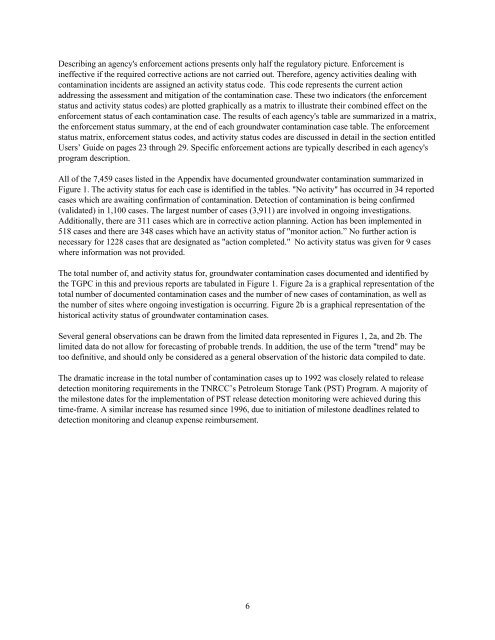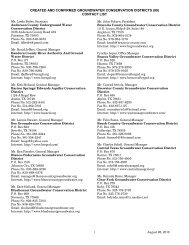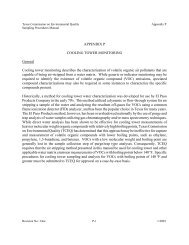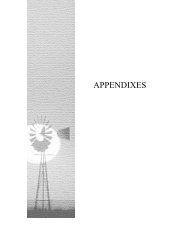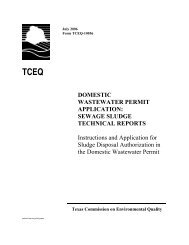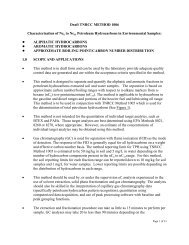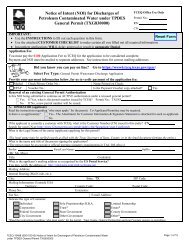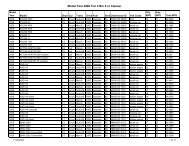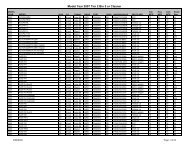joint groundwater report - Texas Commission on Environmental ...
joint groundwater report - Texas Commission on Environmental ...
joint groundwater report - Texas Commission on Environmental ...
Create successful ePaper yourself
Turn your PDF publications into a flip-book with our unique Google optimized e-Paper software.
Describing an agency's enforcement acti<strong>on</strong>s presents <strong>on</strong>ly half the regulatory picture. Enforcement isineffective if the required corrective acti<strong>on</strong>s are not carried out. Therefore, agency activities dealing withc<strong>on</strong>taminati<strong>on</strong> incidents are assigned an activity status code. This code represents the current acti<strong>on</strong>addressing the assessment and mitigati<strong>on</strong> of the c<strong>on</strong>taminati<strong>on</strong> case. These two indicators (the enforcementstatus and activity status codes) are plotted graphically as a matrix to illustrate their combined effect <strong>on</strong> theenforcement status of each c<strong>on</strong>taminati<strong>on</strong> case. The results of each agency's table are summarized in a matrix,the enforcement status summary, at the end of each <str<strong>on</strong>g>groundwater</str<strong>on</strong>g> c<strong>on</strong>taminati<strong>on</strong> case table. The enforcementstatus matrix, enforcement status codes, and activity status codes are discussed in detail in the secti<strong>on</strong> entitledUsers’ Guide <strong>on</strong> pages 23 through 29. Specific enforcement acti<strong>on</strong>s are typically described in each agency'sprogram descripti<strong>on</strong>.All of the 7,459 cases listed in the Appendix have documented <str<strong>on</strong>g>groundwater</str<strong>on</strong>g> c<strong>on</strong>taminati<strong>on</strong> summarized inFigure 1. The activity status for each case is identified in the tables. "No activity" has occurred in 34 <str<strong>on</strong>g>report</str<strong>on</strong>g>edcases which are awaiting c<strong>on</strong>firmati<strong>on</strong> of c<strong>on</strong>taminati<strong>on</strong>. Detecti<strong>on</strong> of c<strong>on</strong>taminati<strong>on</strong> is being c<strong>on</strong>firmed(validated) in 1,100 cases. The largest number of cases (3,911) are involved in <strong>on</strong>going investigati<strong>on</strong>s.Additi<strong>on</strong>ally, there are 311 cases which are in corrective acti<strong>on</strong> planning. Acti<strong>on</strong> has been implemented in518 cases and there are 348 cases which have an activity status of "m<strong>on</strong>itor acti<strong>on</strong>.” No further acti<strong>on</strong> isnecessary for 1228 cases that are designated as "acti<strong>on</strong> completed." No activity status was given for 9 caseswhere informati<strong>on</strong> was not provided.The total number of, and activity status for, <str<strong>on</strong>g>groundwater</str<strong>on</strong>g> c<strong>on</strong>taminati<strong>on</strong> cases documented and identified bythe TGPC in this and previous <str<strong>on</strong>g>report</str<strong>on</strong>g>s are tabulated in Figure 1. Figure 2a is a graphical representati<strong>on</strong> of thetotal number of documented c<strong>on</strong>taminati<strong>on</strong> cases and the number of new cases of c<strong>on</strong>taminati<strong>on</strong>, as well asthe number of sites where <strong>on</strong>going investigati<strong>on</strong> is occurring. Figure 2b is a graphical representati<strong>on</strong> of thehistorical activity status of <str<strong>on</strong>g>groundwater</str<strong>on</strong>g> c<strong>on</strong>taminati<strong>on</strong> cases.Several general observati<strong>on</strong>s can be drawn from the limited data represented in Figures 1, 2a, and 2b. Thelimited data do not allow for forecasting of probable trends. In additi<strong>on</strong>, the use of the term "trend" may betoo definitive, and should <strong>on</strong>ly be c<strong>on</strong>sidered as a general observati<strong>on</strong> of the historic data compiled to date.The dramatic increase in the total number of c<strong>on</strong>taminati<strong>on</strong> cases up to 1992 was closely related to releasedetecti<strong>on</strong> m<strong>on</strong>itoring requirements in the TNRCC’s Petroleum Storage Tank (PST) Program. A majority ofthe milest<strong>on</strong>e dates for the implementati<strong>on</strong> of PST release detecti<strong>on</strong> m<strong>on</strong>itoring were achieved during thistime-frame. A similar increase has resumed since 1996, due to initiati<strong>on</strong> of milest<strong>on</strong>e deadlines related todetecti<strong>on</strong> m<strong>on</strong>itoring and cleanup expense reimbursement.6


